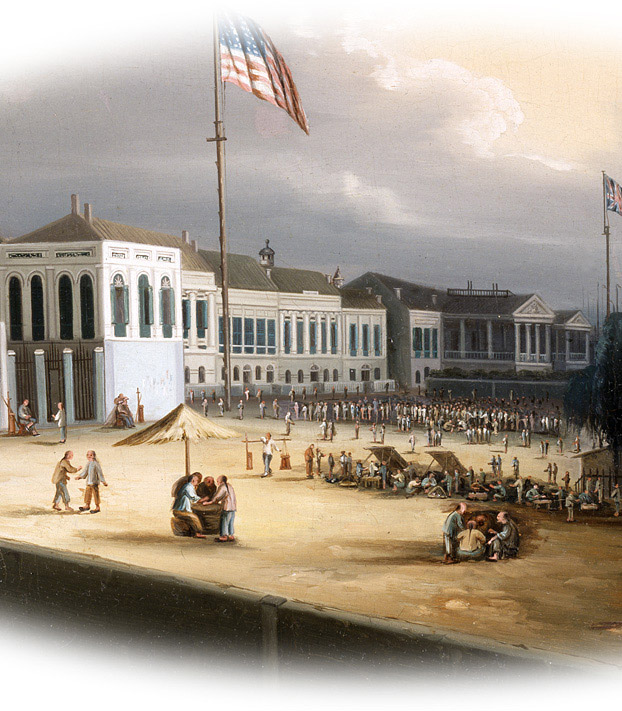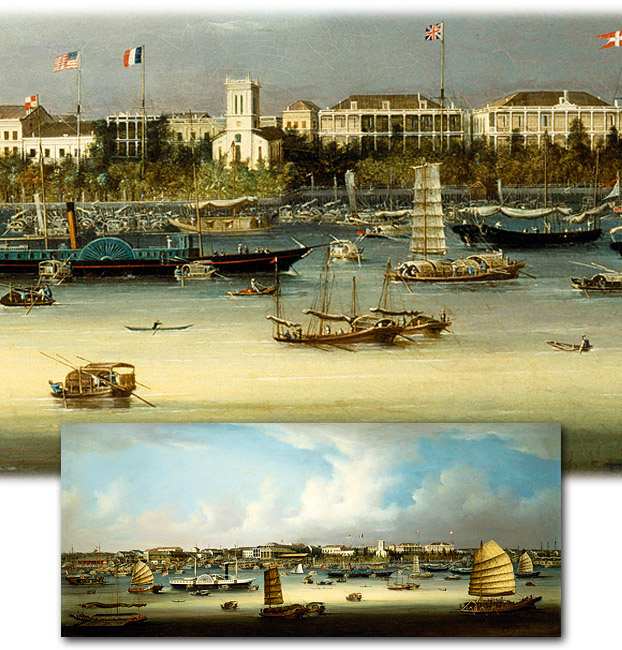| |
The End of the Canton System
Despite their common interests, relations between the foreigners and the Chinese community grew more tense during the early 19th century. The increasing amount of trade and larger number of ships inevitably brought more conflict. The imperial court’s growing concern about the illegal opium trade led to more restrictions and anti-foreign attitudes, while the victories of the British in the Napoleonic wars bred more self-confidence and contempt for China’s resistance to opening additional ports to trade.
The “Terranova incident” of 1821 illustrated how the close and tense relationship between ships’ crews and sampan vendors could seriously endanger the entire China trade. Francis Terranova, an illiterate Italian seaman on the American ship Emily, was accused by the Chinese of killing a Chinese boat-woman with whom he had been bargaining. (Terranova allegedly threw an olive jar that hit her in the head, causing her to drown.) When the captain of the Emily refused to turn Terranova over for punishment, the Chinese suspended trade and arrested the hong merchant Eshing, who was not only responsible for the behavior of the foreigners but also owed large sums of money to the Americans. Confronted with this dilemma, and possibly to prevent the Chinese from inspecting the hold for smuggled opium, the Americans surrendered Terranova to the Chinese, who executed him by strangulation a few days later, notwithstanding assurances to the contrary. The incident shocked the foreign community, who regarded the trial as a mockery of justice. The British criticized the Americans for being too compliant toward the Chinese authorities:As for the Americans who have thus barbarously abandoned a man serving under their flag to the sanguinary laws of this empire without an endeavour to obtain common justice for him, their conduct deserves to be held in eternal execration by every moral, honorable and feeling mind. (Hosea Ballou Morse, Chronicles, volume 4, p. 26)
In Chinese eyes, honor and morality clearly resided on their side rather than that of the drug-dealing foreigners. The steady rise of illegal opium trade hardened the Chinese mood toward foreigners, who in turn resented their dependency on the Chinese who provisioned them and the officials who ruled them. When the British tried to bring a number of women into the factories in 1830, challenging official regulations, the women were quickly expelled. These tensions came to a head in the late 1830s, when the Canton system of Chinese control over the foreigners essentially entered its death throes, triggered in large part by the toxic mainstay of the Western export trade: opium. Nothing was the same thereafter—including even the spatial connections between the foreign factories and local Chinese community.There is also the setting of Canton itself in the 1830s and ’40s, a hotbed of cultural and commercial competition in the period of the Opium Wars. Bounded to the south by the Pearl River and cut off from the general population by the city’s sizable and well-guarded walls, the claustrophobic foreign factory sector of Canton, adjacent to the old walled city was small enough to be measured in footsteps by its pent-up foreign occupants: 270 paces from one end to the other along the riverfront and a mere 50 from the shore to the shops and factories, or hongs, as they were called. On this strip of land, all of the trade between China and the West was carried out. (Stephen Rachman, Memento Morbi: Lam Qua’s Paintings, Peter Parker’s Patients)
Confronted by both the expiration of the East India Company’s monopoly in 1834 and a steady surge in opium smuggling by private traders, in 1838 and 1839 Chinese authorities attempted to crack down on the illegal drug trade by executing several Chinese opium dealers in the large open space between the factories and the Pearl River known as Respondentia Square—an unfenced area that functioned much like traditional Chinese open-air markets as a gathering place for vendors, entertainers, beggars, thieves, and occasional rowdy gangs. Several English sailors who were present tried to prevent the executions in 1839, but they came under attack by Chinese crowds and retreated to the factories for safety. The crowds drove out the local police and attacked the factories with stones and battering rams. Just as they broke into the English factory, Chinese troops arrived to disperse them.
|
|
 |
| |
1825 to 1835: A sizeable Chinese community lived in close proximity to the foreign factories to serve the residents’ needs, and beginning in the 1820s Respondentia Walk—known simply as “The Square”—catered to the traders in the tradition of Chinese open-air markets. This peaceful scene conveys the easy access of the Chinese population to the open ground outside the American factory before the Opium War of 1839 to 1842.
“The Factories of Canton,” 1825–1835
attributed to Lam Qua, oil on canvas
Peabody Essex Museum [cwC_1825-35_M3793]
| |
| |
Full-scale war erupted between China and Britain in 1839, after the Chinese attempted to cut off exports of tea, which Chinese authorities believed to be essential to the British economy. This, they hoped, would pressure England into suppressing opium smuggling. When the British responded instead by insisting on their right to trade freely in the illegal drug, the Chinese mobilized troops and ships to blockade the factories. The Chinese lost the Opium War when British ships bombarded Chinese forts and forced their way into Canton. The treaties that ended the war compelled the Chinese to allow free trade in opium as well as other goods, with a low fixed tariff.
|
|
| |
1839: The abortive Chinese blockade of the factories.
“Blockade of the Factories by the Chinese,” March 24–May 21, 1839
unknown artist
Peabody Essex Museum [cwC_1839_ct431_Blockade]
| |
| |
During these years of conflict, while the warships fought at sea the merchants defended themselves by fencing in Respondentia Walk. After the Opium War, further riots led to the destruction of three factories. In response foreign merchants built the American Garden, a large space surrounded by a high fence designed to keep out the Chinese and provide recreation for Americans and Europeans within.
As the fences rose up, curious Chinese often pressed against them to watch the Westerners promenading in their cage. In a riot in 1846, the crowd chased an English merchant from Old China Street into a factory nearby, whereupon a detachment of armed foreigners marched out to break up the crowd, wounding and capturing several of them. After this riot, the foreigners obtained permission to block up the notorious Hog Lane, source of fires and troublemakers, and expand the American Garden. In 1847 an Anglican Church was built in front of the new factories, dominating most panoramic renderings and replacing the pagodas and mountains of earlier times.
|
|

Tension & Isolation in “The Square”

|
| |
1839 to 1840: Respondentia Walk separated by a fence from what would become the American Garden (note the first few trees behind the fence). To the left a gated passage leads to Old China Street which was flanked on the left by Chung Qua’s factory and on the right by the American factory.
“View of the Factories,” 1839–40
unknown Chinese artist
Peabody Essex Museum [cwC_E81458]
|
|
| |
1844 to 1845: The American Garden with a fully developed park. In 1843, the curiosity of Chinese crowds peering at the foreigners in the fenced-in garden led to a conflict in which the foreigners beat the Chinese with sticks. The Boston merchant Paul Forbes blamed this on the “overbearing impudence of the foreigners as much as any blame of the Chinese.” From this time on, foreigners disturbed by Chinese crowds walled themselves off even more securely from the surrounding population.
“The American Garden,” 1844–45
Unknown Chinese artist
Peabody Essex Museum [cwC_1844-45_E82881]
| |
 |
| |
1850 to 1855: In the early 1850s, panoramic views of Canton depicted a port city vastly different from the scene before the first Opium War. Fenced-off gardens covered the waterfront. The Anglican Church built in 1847 dominated the architectural profile while pagodas, hitherto so prominent in artistic renderings, faded from the scene. And the busy harbor itself, previously clogged only with Chinese ships, now bustled with shallow-draft Western steamships. This new vista was short-lived, however, for in 1856 fire destroyed the entire complex of foreign factories and they were never rebuilt.
“Foreign Factory Site,” 1850–55, attributed to Sunqua
Peabody Essex Museum [cwC_1850-55_M205674]
|
|
| |
The increasingly isolated factories remained peaceful and undisturbed for a decade, but in 1856 another fire destroyed them completely, just as the Chinese and foreigners began mobilizing for a second Opium War. After their loss in this war, China had to open more treaty ports and allow foreigners access to the interior, but the foreign enclave in Canton still attracted a majority of the foreign traders. The entire trade area first moved to temporary quarters on Honam Island across the Pearl River, and then to a manmade island further up the river named Shamian. Shamian Island was entirely cut off from the local population, accessible only over two guarded bridges.
|
|
| |
1856: Fire destroys the foreign factories in Canton just as a
second Opium War was erupting.
“The Burning of the Factories, Canton,” 1856
by Sunqua
Peabody Essex Museum [cwC_1856_ct435]
|
|
| |
1857–61: Honam Island, across the Pearl River from the Canton factories destroyed in the fire of 1856, became the temporary quarters of the foreign traders. As this painting reveals, the harbor remained as busy as ever, but the hastily erected buildings were modest. During the second Opium War of 1856 to 1860, the American steamship Willamette that centers this panorama participated in the hostilities by towing the sailing sloop-of-war Portsmouth into position.
“Godowns in Honam,” 1857–1861, unknown Chinese artist
Hong Kong Museum of Art [cwC_1857-61_AH6443]
| |
| |
This 1858 map of Canton shows the “New Foreign Factories” (see inset) to be located on Shamian Island, a manmade island connected to—or, more accurately, separated from—the mainland by two bridges.
Map of Canton, 1858
Peabody Essex Museum [cwC_1858_E78602]
|
|
| |
1865: the new foreign enclave—brightly colored in the lower left—on reclaimed land at Shamia Island. The great expanse of Canton, with its two city walls, spreads out to the right.
“View of Canton,” 1865, unknown Chinese artist
Peabody Essex Museum [cwC_1865_M10867]
| |
| |
1883: The foreign factories on Shamian Island 20 years later, as seen from the mainland. Much of the land remains undeveloped, and the foreign settlement is clustered at one corner of the island, with a church and ships visible in the distance. One of the two bridges connecting the island to the mainland is visible on the right, with Chinese sampans clustered around it.
“Shamien, the Foreign Settlement”
Newspaper engraving, after a photograph by John Thomson
The Graphic, September 22, 1883, page 293
from the author's collection (Farris), reproduced here by kind permission
of the Illustrated London News Picture Library
[cwC_1850s_ShamienThomson]
|
|
| |
By the late 1850s the trading scene at and around Canton was flourishing as actively as ever. The great city maintained its dominant position for a long time, but competition from the newly opened treaty ports, especially Hong Kong and Shanghai, reduced its relative importance. Export paintings declined in popularity as photography arrived, and foreigners gained access to the interior. Images of China focused more widely on the entire empire, not just the limited foreign sector. Westerners now saw much more of China, but with a less intensive gaze, and religious and historical monuments replaced ships and traders as the primary subject of interest.
|
|
|

